I'm using SqlServerCompact, Entity framework with code-first and I'm generating the connection string dinamically because the database it's generated when the user requests it.
I followed suggestions from this question: How do I programmatically set the connection string for Entity-Framework Code-First? however, I still have problems, infact I get an exception complaining that the schema in the model is not the same as used in code.
That's obvius however, I want the schema to be generated from code, so I really can't understand why this happen
Can someone help me?Here is the code used:
NerdDinners.cs
class NerdDinners : DbContext
{
public static string CreateConnectionString(string dbPath = @"|DataDirectory|\NerdDinners.sdf")
{
SqlCeConnectionStringBuilder sqlConnection = new SqlCeConnectionStringBuilder();
sqlConnection.Password = "9023fase93";
sqlConnection.DataSource = dbPath;
EntityConnectionStringBuilder connection = new EntityConnectionStringBuilder();
connection.Metadata = @"res://*/NerdDinnersModel.csdl|res://*/NerdDinnersModel.ssdl|res://*/NerdDinnersModel.msl";
connection.Provider = "System.Data.SqlServerCe.3.5";
connection.ProviderConnectionString = sqlConnection.ToString();
return connection.ToString();
}
public NerdDinners() : base() { }
public NerdDinners(string nameOrConnectionString) : base(nameOrConnectionString) { }
public DbSet<Dinner> Dinners { get; set; }
public DbSet<RSVP> RSVPs { get; set; }
protected override void OnModelCreating(DbModelBuilder modelBuilder)
{
Database.SetInitializer<NerdDinners>(new NerdDinnersInitializer());
Database.DefaultConnectionFactory = new SqlCeConnectionFactory("System.Data.SqlServerCe");
base.OnModelCreating(modelBuilder);
}
}
Program.cs
class Program
{
static void Main(string[] args)
{
NerdDinners nerdDinner = new NerdDinners(NerdDinners.CreateConnectionString());
Console.WriteLine("Inizio test");
var res = from d in nerdDinner.Dinners
select d;
Console.WriteLine("Dinners:");
foreach (var item in res)
Console.WriteLine(item.ToString());
Console.WriteLine("End");
// Usato per terminazione
Console.ReadKey();
}
}
An this is my solution situation (an image):

EDIT 1:
The error is a MetadataException, it complains about invalid schema
EDIT 2:
NerdDinnersInitializer.cs
class NerdDinnersInitializer : DropCreateDatabaseAlways<NerdDinners>
{
public NerdDinnersInitializer() : base() { }
protected override void Seed(NerdDinners context)
{
var toadd = new List<Dinner>
{
new Dinner
{
Address = "bla",
DinnerID = 0,
EventDate = DateTime.Parse("2010-12-03"),
HostedBy = "mclink",
Title = "Notitle",
},
new Dinner
{
Address = "Fiwe",
DinnerID = 0,
EventDate = DateTime.Parse("2011-12-03"),
HostedBy = "ngi",
Title = "Bah",
},
};
toadd.ForEach(item => context.Dinners.Add(item));
context.SaveChanges();
base.Seed(context);
}
}